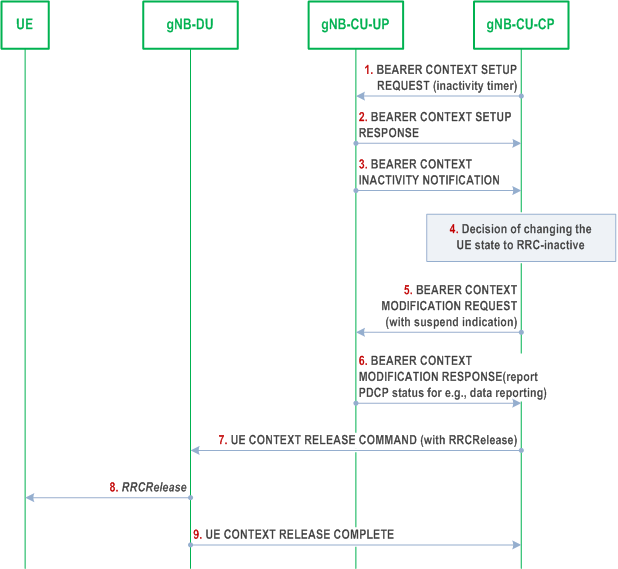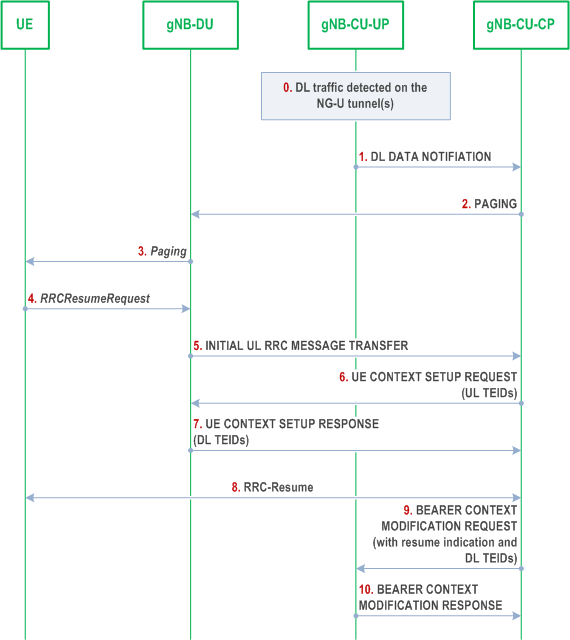Content for TS 38.401 Word version: 18.2.0
1…
5…
6…
6.1.4
6.1.5…
6.2…
7…
8…
8.2…
8.2.1.4…
8.2.2…
8.2.3…
8.2.4
8.2.5
8.3…
8.4…
8.4.4…
8.5…
8.9…
8.9.4…
8.9.6…
8.9.7…
8.10
8.11…
8.12…
8.13…
8.14…
8.15…
8.15.2…
8.16…
8.17…
8.17.3…
8.17.4
8.18…
8.19…
8.19.2
8.19.3
8.19.4…
8.21…
8.22…
8.23…
8.24…
9…
A…
8.9.6 RRC State transition
8.9.6.1 RRC Connected to RRC Inactive
8.9.6.2 RRC Inactive to other states
...
...
8.9.6 RRC State transition p. 75
8.9.6.1 RRC Connected to RRC Inactive p. 75
The procedure for changing the UE state from RRC-connected to RRC-inactive is shown in Figure 8.9.6.1-1.

Step 1.
The gNB-CU-CP sends BEARER CONTEXT SETUP REQUEST message with UE/PDU session/DRB level inactivity timer.
Step 2.
The gNB-CU-UP sends BEARER CONTEXT SETUP RESPONSE message.
Step 3.
The gNB-CU-UP sends BEARER CONTEXT INACTIVITY NOTIFICATION message with inactivity monitoring results.
Step 4.
The gNB-CU-CP determines that the UE should enter RRC-inactive (e.g., after receiving Bearer Context Inactivity Notification procedure).
Step 5.
The gNB-CU-CP sends BEARER CONTEXT MODIFICATION REQUEST message with a Bearer Context Status Change to the gNB-CU-UP, which indicates that the UE is entering RRC-inactive state. The gNB-CU-CP keeps the F1 UL TEIDs.
Step 6.
The gNB-CU-UP sends the BEARER CONTEXT MODIFICATION RESPONSE message including the PDCP UL and DL status that may be needed for e.g., data volume reporting. The gNB-CU-UP keeps the Bearer Context, the UE-associated logical E1-connection, the NG-U related resource (e.g., NG-U DL TEIDs) and the F1 UL TEIDs.
Step 7.
The gNB-CU-CP sends the UE CONTEXT RELEASE COMMAND message to the gNB-DU serving the UE, together with the RRCRelease message to be sent to the UE.
Step 8.
The gNB-DU sends the RRCRelease message to the UE.
Step 9.
The gNB-DU sends the UE CONTEXT RELEASE COMPLETE message to the gNB-CU-CP.
8.9.6.2 RRC Inactive to other states p. 76
The procedure for changing the UE state from RRC-inactive to RRC-connected is shown in Figure 8.9.6.2-1.

Step 0.
The gNB-CU-UP receives DL data on NG-U interface.
Step 1.
The gNB-CU-UP sends DL DATA NOTIFICATION message to the gNB-CU-CP.
Step 2.
The gNB-CU-CP sends PAGING message to the gNB-DU.
Step 3.
The gNB-DU sends the Paging message to the UE.
Step 4.
The UE sends RRCResumeRequest message either upon RAN paging or UL data arrival.
Step 5.
The gNB-DU sends the INITIAL UL RRC MESSAGE TRANSFER message to the gNB-CU-CP.
Step 6.
The gNB-CU-CP sends UE CONTEXT SETUP REQUEST message including the stored F1 UL TEIDs to create the UE context in the gNB-DU.
Step 7.
The gNB-DU responds with the UE CONTEXT SETUP RESPONSE message including the F1 DL TEIDs allocated for the DRBs.
Step 8.
The gNB-CU-CP and the UE perform the RRC-Resume procedure via the gNB-DU.
Step 9.
The gNB-CU-CP sends BEARER CONTEXT MODIFICATION REQUEST message with a RRC Resume indication, which indicates that the UE is resuming from RRC-inactive state. The gNB-CU-CP also includes the F1 DL TEIDs received from the gNB-DU in step 7.
Step 10.
The gNB-CU-UP responds with theBEARER CONTEXT MODIFICATION RESPONSE message.